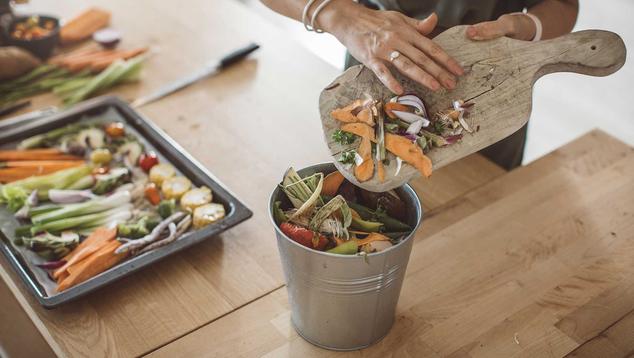Leftover use and overreliance on date labels -- “best if used by” or “use by” dates -- are two of the primary contributors to food waste in American homes, according to new research by MITRE and Gallup. The research also shows that while saving money is the primary motivator for Americans seeking to reduce their food waste, only a third accurately estimate the magnitude of the potential savings.
These findings come from a recent study on consumer attitudes, behavior and awareness related to food waste that included a daily diary component for participants to track their household food waste over seven days using an app. The study offers important insights into how the country and consumers might address this issue, which costs the U.S. an estimated $310 billion annually.
Food Waste a Top Consumer Concern About U.S. Food System
MITRE, a not-for-profit organization that applies systems thinking across government, industry and academia, initiated the national survey through its independent research and development program. The goal was to better understand how and why people are wasting food at the household level, which contributes to nearly 50% of food waste in the country.
According to the June 21-Aug. 23 poll of over 9,200 U.S. adults, surveyed by web and mail, Americans recognize food waste carries both individual and societal repercussions, and 86% think American households should do more to reduce the amount of food they waste.
Food waste ranks among the top three most significant food-related concerns consumers have out of 15 issues listed in the survey. Food waste ranks third, cited by 34%, coming in behind food prices (81%) and the healthiness of what people eat (56%). It is roughly on par with concerns about hormones, steroids or antibiotics in food (31%), while it exceeds concerns about food poisoning (26%), the amount of food packaging (16%) and the impact of food production on the environment (12%), among other issues.
What Is Fueling Food Waste?
A subset of survey respondents were invited to use a smartphone application developed by MITRE to track their daily food waste for seven consecutive days, including the amount and type of food involved, where they obtained it, and why they discarded it. While this was a pilot study of the MITRE food-waste diary app, the results are projectable to the U.S. English-speaking population.
The survey data reveal several key behaviors associated with higher household food waste. Of all the behaviors monitored, throwing out leftovers is identified as the largest contributor to household food waste. Those who report frequently throwing away leftovers because no one wanted to eat them waste far more (an estimated 12 cups of food per week, on average) than those who infrequently throw out leftovers (3.5 cups per week).
The study also shows that Americans who rely heavily on date labels such as “sell by” or “use by” -- generally indicators of freshness, not safety -- tend to waste more food. Respondents who say they often or always dispose of food that has passed its date label throw out an estimated 8.9 cups of food per week, compared with 4.0 cups among those who say they never or rarely throw away food for the same reason.
From a demographic perspective, having children at home is associated with greater waste, as households with children waste 8.5 cups of food per week, on average, compared with 5.1 cups among those without children at home. Adults in households with children also report a higher tendency to rely on date labels when deciding to purchase or throw away food.
The Financial Burdens of Food Waste
Multiple survey findings indicate that consumers are sensitive to the financial costs of wasting food. In addition to identifying price as their top food-related concern, 82% cite saving money as the top motivating factor for reducing waste, and 89% believe throwing away food is a waste of money.
At the same time, consumers largely underestimate the potential savings of wasting less. Only 33% of respondents are aware that by not wasting food, they could save at least $1,500 annually. About half (49%) incorrectly believe the potential savings would be less than that.
The data reveal that other motivating factors for reducing waste include wanting to manage one’s home efficiently (76%) and feelings of guilt when throwing food away that could have been eaten (60%). While reducing environmental impacts ranks as the weakest motivator to reduce food waste (40%), Americans do exhibit awareness of the environmental aspect. A slim majority (55%) say climate change is a consequence of food waste, and 63% believe pollution of land, water or air is a consequence.
American Sentiments on Food Waste
In conjunction with examining the behaviors and attitudes driving food waste, the study reveals how Americans think and feel about the issue. Many Americans (53%) agree there are actions they can take to tackle the food waste issue, with only 23% saying there is not much they can do to minimize the amount of food they throw away.
Relatedly, most Americans (71%) report feeling guilty when they throw food away, and 60% identify guilt as one of their primary motivators for trying to minimize the amount of food they waste.
Bottom Line
The MITRE-Gallup National Food Waste Survey reveals that the average American household wastes 6.2 cups of food per week. Additionally, respondents estimate that approximately 36% of food produced in the U.S. each year is thrown away, which closely mirrors the U.S. Food and Drug Administration’s estimate of 30% to 40%. This waste contributes to a host of negative economic and environmental consequences. More hopefully, the study also finds that the majority of Americans want to reduce their waste and reveals some simple yet effective practices and messages that could be effective at influencing change.
Encouraging Americans to consume leftovers, and to reduce leftover production in the first place by ordering or cooking less, is a prime strategy for food waste reduction. Educational initiatives to boost the public’s understanding of the meaning of food date labels can also significantly contribute to waste reduction.
For more information, read the full MITRE-Gallup report, The State of Food Waste in America. If you are interested in tracking your own household food waste, download MITRE’s Food Waste Tracker app, available on Android and iOS devices.
To stay up to date with the latest Gallup News insights and updates, follow us on Twitter.
Learn more about how the Gallup Panel works.




